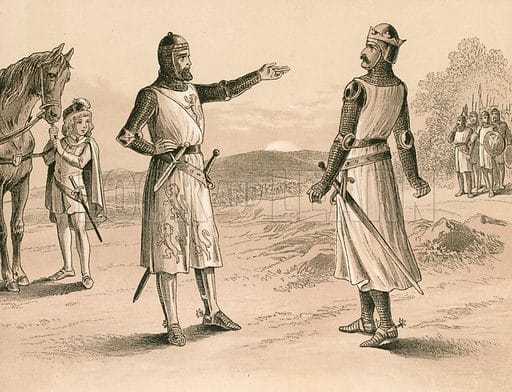Battle of Methven
Background
After the Siege of Stirling Castle, all but one of the Scottish Nobles swore fealty to Edward I of England, including Robert the Bruce. The holdout was William Wallace, who continued to fight the English and was involved in the Action at Earnside before being betrayed and handed over to the English. Wallace was taken to the Tower of London, found guilty of Treason and hanged, drawn, and quartered at Smithfield, in London.

Robert the Bruce was now against Edward I and on February 10th, 1306, killed John Comyn before the high altar of the Greyfriars Church in Dumfries. Robert quickly seized the throne of Scotland and was crowned King of Scots on March 25th, 1306 at Scone.
In response to Robert no longer supporting Edward I and Comyn's murder, Edward gave the order of "no mercy", lifting the laws of chivalry regarding the Bruce.
Aymer de Valence, 2nd Earl of Pembroke, was stationed in Perth on behalf of Edward I as special lieutenant for Scotland. Also with Aymer were Henry Percy, Robert de Clifford, and an army of around 3000 men drawn from northern England.
Battle
On June 19th, 1306, as Robert the Bruce approached Perth with his Scottish army, he called on Valence to come out from behind the walls of Perth and do battle. Valence argued that it was late in the day and that he would accept the challenge to fight the following day.

Robert and his army began to make camp for the night about six miles from Perth, in a forested area near the River Almond and the town of Methven, which held the high ground.
After dusk, as the Bruce's army was making camp and disarming, the English army under Valence launched a surprise attack and swarmed over the camp. Robert unhorsed Valence in the first onslaught but was unhorsed himself and nearly captured by Philip de Mowbray before being rescued.
Outnumbered and taken by complete surprise, the Scottish forces had no chance. Robert the Bruce was unhorsed two more times before a small group of Scottish knights, including James Douglas, Neil Campbell, Edward Bruce, John de Strathbogie, and Gilbert de Haye, as well as King Robert, formed a phalanx, managed to break free, and were forced to flee in defeat.
Aftermath
Many of the Bruce's most loyal followers were left behind to be killed or captured and later executed. A few Scottish Nobles were captured during the battle, including Alexander Fraser, David de Inchmartin, Hugh de Haye, John Somerville, Thomas de Randolph, and Alexander Scrymgeour, the royal standard bearer.
The defeat and setback forced Robert the Bruce to shift from fighting pitched battles to adopting guerrilla warfare tactics.






